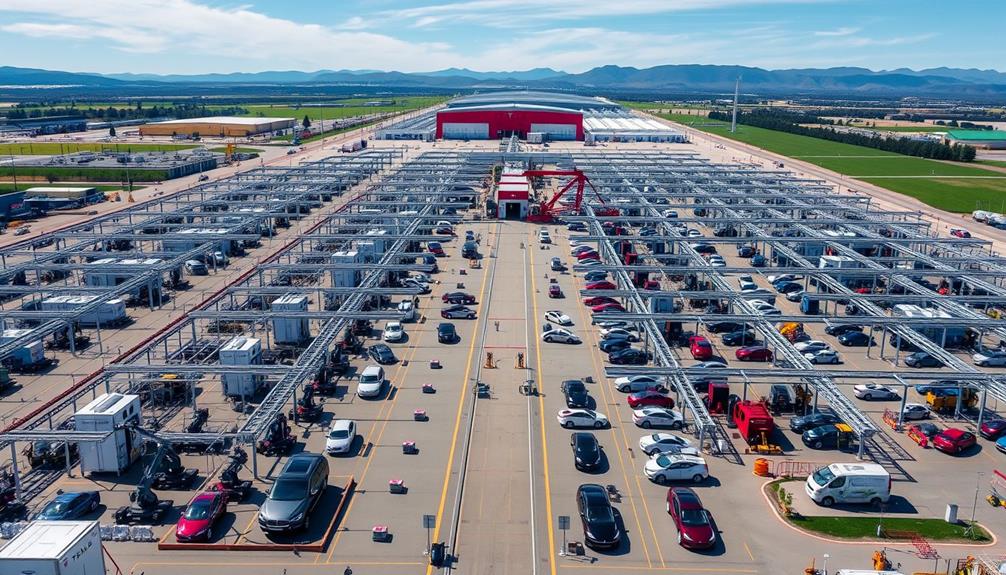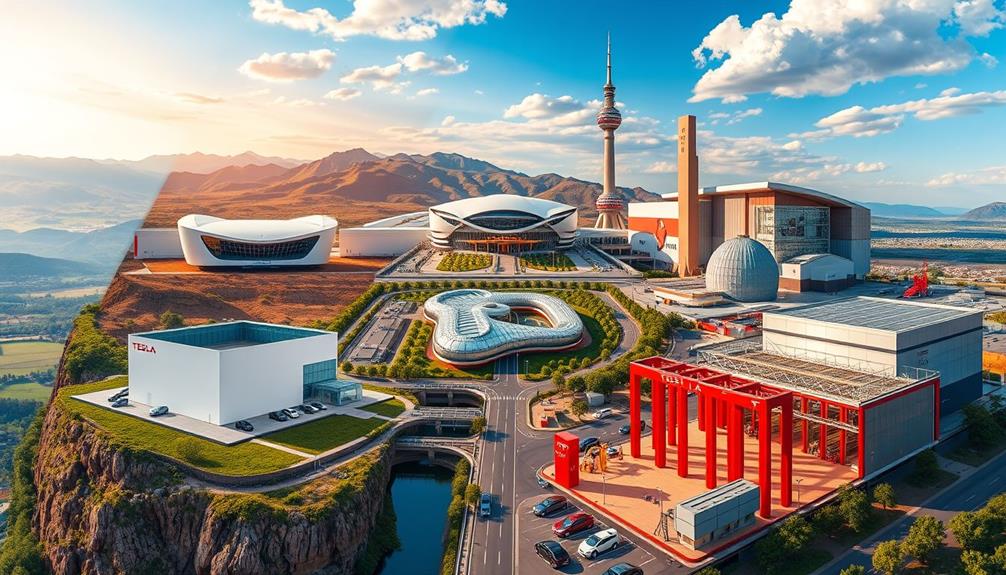Tesla cars are made at several key locations worldwide. The Fremont Factory in California is the heart of production and assembles the Model S, Model X, Model 3, and Model Y. Gigafactory Shanghai focuses on delivering Model 3 and Model Y with an impressive capacity of 950,000 vehicles each year. Other facilities, like Gigafactory Berlin and Gigafactory Nevada, support specific models and battery production. Tesla is also planning more Gigafactories to meet rising demand. Each factory emphasizes sustainability, ensuring eco-friendly practices in manufacturing. If you're curious about the details of each site, there's more intriguing information ahead!
Key Takeaways
- Tesla's primary manufacturing facility is the Fremont Factory in California, producing Model S, Model X, Model 3, and Model Y.
- Gigafactory Shanghai in China specializes in manufacturing Model 3 and Model Y, with an annual capacity exceeding 950,000 vehicles.
- Gigafactory Berlin in Germany focuses on Model Y production with a projected capacity of over 375,000 vehicles annually.
- Gigafactory Nevada primarily manufactures batteries and electric motors, supporting the production of Model 3 vehicles.
- Future Gigafactories are planned in Monterrey, Mexico, along with potential sites in Japan, South Korea, and India to meet global demand.
Overview of Tesla Manufacturing

Tesla's manufacturing approach is a key driver of its success in the electric vehicle market. By strategically locating its manufacturing facilities around the globe, Tesla boosts its production capacity and efficiency. The Fremont Factory in California is well-known for producing the Model S, Model X, Model 3, and Model Y, showcasing Tesla's commitment to quality and innovation.
In addition to its California operations, Tesla has established multiple Gigafactories. The Gigafactory in Shanghai focuses on the Model 3 and Model Y, with a remarkable production capacity exceeding 950,000 vehicles annually.
Similarly, Gigafactory Berlin in Germany is expected to produce over 375,000 Model Y SUVs each year. Tesla's Gigafactory in Texas is currently ramping up production of the Model Y and plans to add the Cybertruck and Roadster to its lineup, leveraging advanced assembly processes like single-piece subframe castings. These innovations aim to streamline manufacturing while reducing complexity and production costs. As Tesla advances its electric vehicle technologies, competitors in the traditional automotive industry are also exploring ways to enhance their offerings, with some enthusiasts focusing on models like the Toyota Tundra Offroad Tuning to optimize performance for rugged terrain. This highlights the broader automotive shift toward customization and innovation, whether through electric advancements or specialized modifications.
With plans to build 10-12 more Gigafactories worldwide, Tesla is poised to meet the growing global demand for electric vehicles. This ambitious expansion reflects Tesla's dedication to revolutionizing manufacturing while delivering cutting-edge electric vehicles to consumers.
Fremont Factory Details

The Fremont Factory is where Tesla's production journey began, and it plays a vital role in their overall capacity.
With space for over 10,000 workers, this facility efficiently churns out popular models like the Model S, Model 3, and more.
Let's take a closer look at its impressive production capabilities and the dedicated workforce behind it.
Production Capacity Overview
Producing vehicles at the Fremont Factory in California highlights Tesla's commitment to meeting the growing demand for electric cars. This original production facility spans 5.3 million square feet and employs over 10,000 Tesla employees, all dedicated to the assembly line that churns out some of the most sought-after models, including the Model S, Model X, Model 3, and Model Y.
With an impressive annual production capacity of approximately 550,000 vehicles, the Fremont Factory serves as a central hub for Tesla's manufacturing efforts. Since its purchase in 2010, the factory has undergone significant remodeling, culminating in the launch of the Model S in June 2012.
This facility is essential in addressing global demand for electric vehicles, ensuring that Tesla remains a leader in the market. The extensive production capabilities at the Fremont Factory not only meet current needs but also bolster Tesla's overall strategy for scaling vehicle production.
Workforce and Roles
At the heart of the Fremont Factory's impressive production output is a dedicated workforce that plays an essential role in Tesla's success. With over 10,000 employees, this diverse workforce collaborates seamlessly with advanced robotics to enhance production efficiency.
You'll find a range of roles available, from Supervisors and Technicians to Production Associates, each contributing to the assembly of Tesla's popular models like the Model S, Model 3, Model X, and Model Y.
If you're looking to start your career in manufacturing, the Fremont Factory offers entry-level positions with on-the-job training, making it accessible for newcomers. This commitment to employee development is mirrored in the competitive benefits Tesla provides, including a 401(k) match, paid time off, and extensive medical coverage.
Working at the Fremont Factory not only means being part of a pioneering team but also enjoying a supportive work environment that values diversity and teamwork.
As you contribute to the production of cutting-edge electric vehicles, you'll also be part of a mission aimed at accelerating the world's shift to sustainable energy.
Global Gigafactory Locations

Tesla's network of Gigafactories plays an essential role in its mission to accelerate the world's shift to sustainable energy.
You'll find Tesla's original manufacturing site in Fremont, California, where they produce the Model S, Model X, Model 3, and Model Y, boasting an annual capacity of 550,000 vehicles. In Sparks, Nevada, and Buffalo, New York, Tesla enhances its production capabilities with battery manufacturing and solar products.
Over in China, Gigafactory Shanghai specializes in the Model 3 and Model Y, supporting the Asian and European markets with an impressive capacity to ship over 950,000 vehicles each year.
Meanwhile, Gigafactory Berlin, which opened in March 2022, focuses on the Model Y SUV and has a projected capacity of over 375,000 vehicles per year.
Looking ahead, Tesla plans to expand its global footprint with a seventh Gigafactory in Monterrey, Mexico, and potential future sites in Japan, South Korea, and India.
With these locations, Tesla aims to strengthen its electric vehicle production capabilities and meet the growing demand for sustainable transportation worldwide.
Production Capacity by Factory

When it comes to production capacity, each Tesla factory plays a crucial role in meeting the growing demand for electric vehicles.
The Fremont factory in California boasts an impressive annual production capacity of 550,000 vehicles, producing the Model S, Model X, Model 3, and Model Y.
Meanwhile, Gigafactory Nevada primarily focuses on batteries and electric motors but is gearing up for future Tesla Semi production, currently supporting Model 3 manufacturing.
Across the ocean, Gigafactory Berlin is making strides with an annual capacity of over 375,000 Model Y vehicles, bolstering Tesla's presence in the European market.
In Asia, Gigafactory Shanghai has ramped up its production considerably, shipping over 950,000 units of Model 3 and Model Y each year to both Asian and European customers.
Sustainability Practices in Manufacturing

When you think about Tesla's manufacturing, consider how they prioritize renewable energy and eco-friendly designs in their factories.
Each facility incorporates strategies to reduce waste and optimize energy usage, reflecting their commitment to sustainability.
As Tesla ramps up production, these practices play an essential role in their vision for a greener future.
Renewable Energy Usage
In recent years, Tesla has made significant strides in integrating renewable energy into its manufacturing processes. By harnessing solar panels at many Gigafactories, Tesla reduces its reliance on non-renewable energy sources, aiming for a sustainable facility that minimizes environmental impact.
| Gigafactory Location | Renewable Energy Features |
|---|---|
| Nevada | Built without natural gas; energy-efficient thermal systems |
| Berlin | Marketed as Tesla's most sustainable facility; ecological initiatives in place |
| Shanghai | Utilizes solar panels to power operations; continuous energy usage monitoring |
At the Nevada Gigafactory, energy-efficient systems are critical for minimizing the carbon footprint. The Berlin facility, despite local opposition, showcases Tesla's commitment to ecological initiatives. Additionally, continuous monitoring of energy usage allows Tesla to optimize production processes while prioritizing sustainability. By focusing on renewable energy, Tesla not only enhances its manufacturing efficiency but also sets a benchmark for reducing the automotive industry's overall environmental impact. Embracing these practices, Tesla is leading the charge towards a greener future in car manufacturing.
Eco-Friendly Factory Designs
Tesla's commitment to sustainability goes beyond just renewable energy usage; it extends into the very design of their factories. Each Gigafactory is crafted to be a sustainable facility, minimizing their environmental impact through innovative features. For instance, the Nevada Gigafactory operates without a natural gas connection, relying on energy-efficient thermal systems that considerably reduce energy consumption.
The Berlin Gigafactory stands out as Tesla's most sustainable facility, showcasing eco-friendly manufacturing practices that prioritize the use of renewable energy. It's equipped with solar panels that harness clean energy, powering production processes while decreasing reliance on non-renewable sources. This commitment to green energy not only supports Tesla's goals but also sets a standard for the automotive industry.
Additionally, Tesla incorporates ecological features into their factory designs. At the upcoming Gigafactory Texas, plans include public walking trails that promote sustainability and environmental stewardship, allowing the community to engage with the surrounding ecosystem.
Waste Reduction Strategies
Waste reduction is a key focus in Tesla's manufacturing strategy, ensuring that production processes not only minimize waste but also promote recycling and reuse. By leveraging renewable energy, like solar panels at many Gigafactories, Tesla greatly reduces its carbon footprint.
For instance, the Nevada Gigafactory operates without a natural gas connection, utilizing energy-efficient thermal systems that optimize energy use and minimize waste generation.
You'll find that continuous monitoring of energy consumption is central to Tesla's approach. This commitment to energy efficiency helps the company reduce overall resource use, aligning with its sustainability goals.
The Gigafactory Berlin stands out as Tesla's most sustainable facility, incorporating eco-friendly practices despite facing local opposition.
With these strategies, Tesla not only manufactures electric vehicles but also leads the charge in sustainable manufacturing.
By focusing on waste reduction and utilizing renewable energy sources, Tesla is setting a new standard in the automotive industry, proving that eco-friendly practices can coexist with innovative production methods.
Embracing these principles, you can see how Tesla's commitment to sustainability shapes its operations and impacts the environment positively.
Future Expansion Plans

With plans to establish a seventh Gigafactory in Monterrey, Mexico, Tesla is gearing up to enhance its production capabilities greatly.
This new facility will play an essential role in Tesla's global expansion strategy, allowing the company to produce more affordable electric vehicles and energy products to meet rising demand.
Tesla's vision includes constructing 10-12 additional Gigafactories worldwide, markedly bolstering its manufacturing capacity.
Ongoing discussions suggest potential sites in Japan, South Korea, and India, aiming to improve logistical efficiency in Asia.
Current projects like Gigafactory Berlin and Gigafactory Texas are already set to ramp up production capabilities in Europe and the U.S., further solidifying Tesla's market presence.
Frequently Asked Questions
Where Are Tesla Cars Manufactured?
You're likely curious about where Tesla cars are manufactured. Tesla operates multiple factories, including locations in California, Nevada, China, and Germany, each producing various models to meet global demand and enhance efficiency in production.
Are Tesla Cars Made in China?
Yes, Tesla cars are made in China at Gigafactory Shanghai. This facility produces the Model 3 and Model Y, greatly boosting Tesla's production capacity for Asian and European markets while playing a key role in global distribution.
Where Are Teslas Sold in the US Made?
Tesla cars sold in the U.S. are primarily made at the Fremont Factory in California. You'll also find production happening at the Austin Gigafactory and Gigafactory Nevada, enhancing Tesla's manufacturing capabilities across the country.
Who Builds Tesla Cars?
You'll find that Tesla cars are built by a dedicated workforce at multiple factories. Engineers and technicians collaborate to design, assemble, and innovate, ensuring each vehicle meets high standards of quality and performance.
Conclusion
To sum up, Tesla's commitment to innovation and sustainability shines through its global manufacturing network. By strategically placing Gigafactories around the world, Tesla not only boosts production capacity but also reduces its carbon footprint. You might've heard that electric cars are just a trend, but with Tesla's continuous expansion and focus on eco-friendly practices, it's clear they're here to stay. So, keep an eye on Tesla as they reshape the future of transportation!










